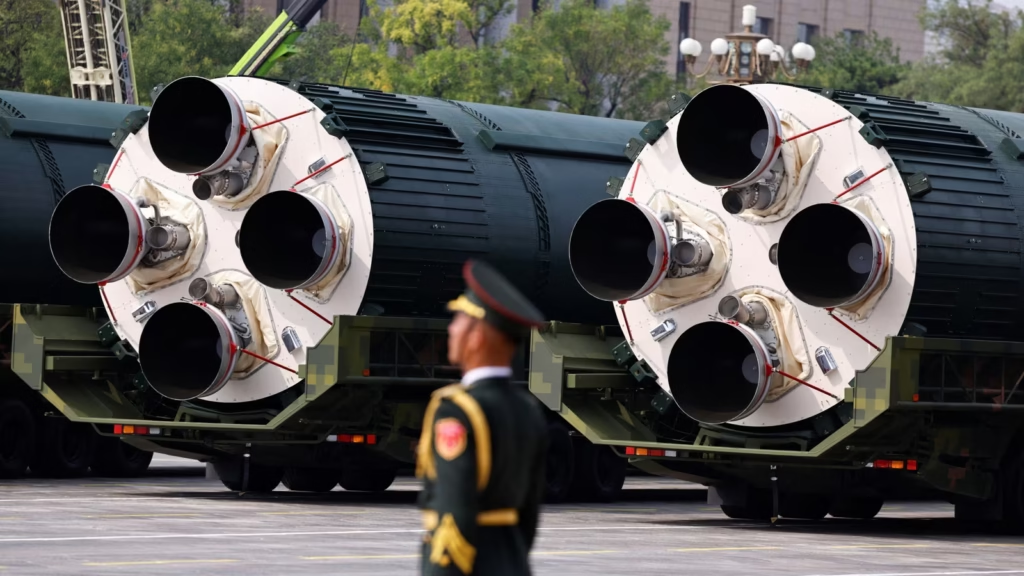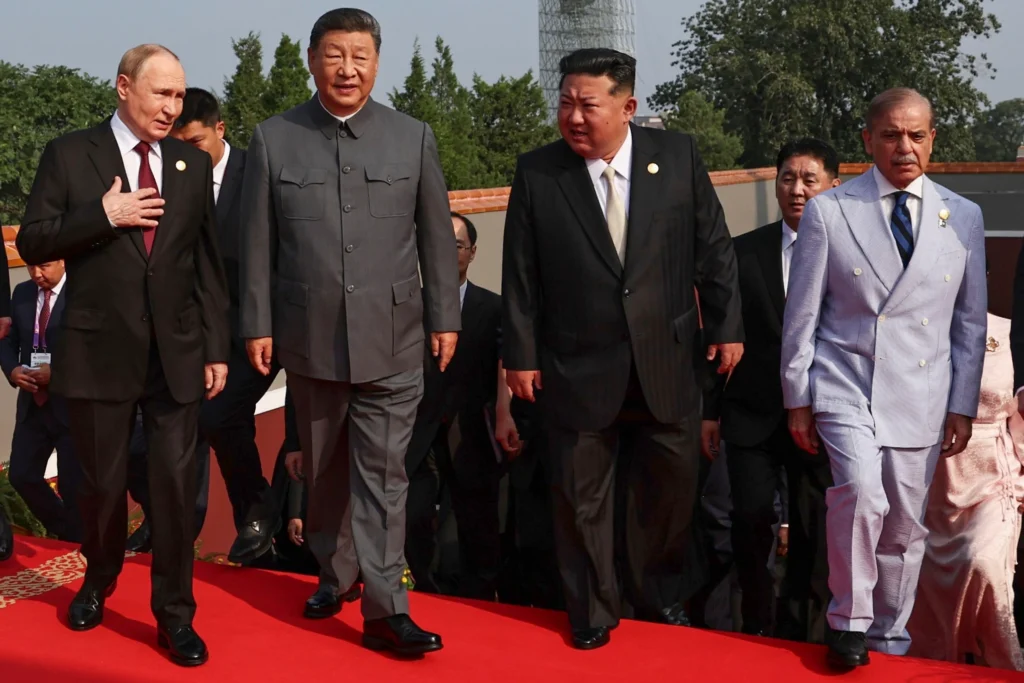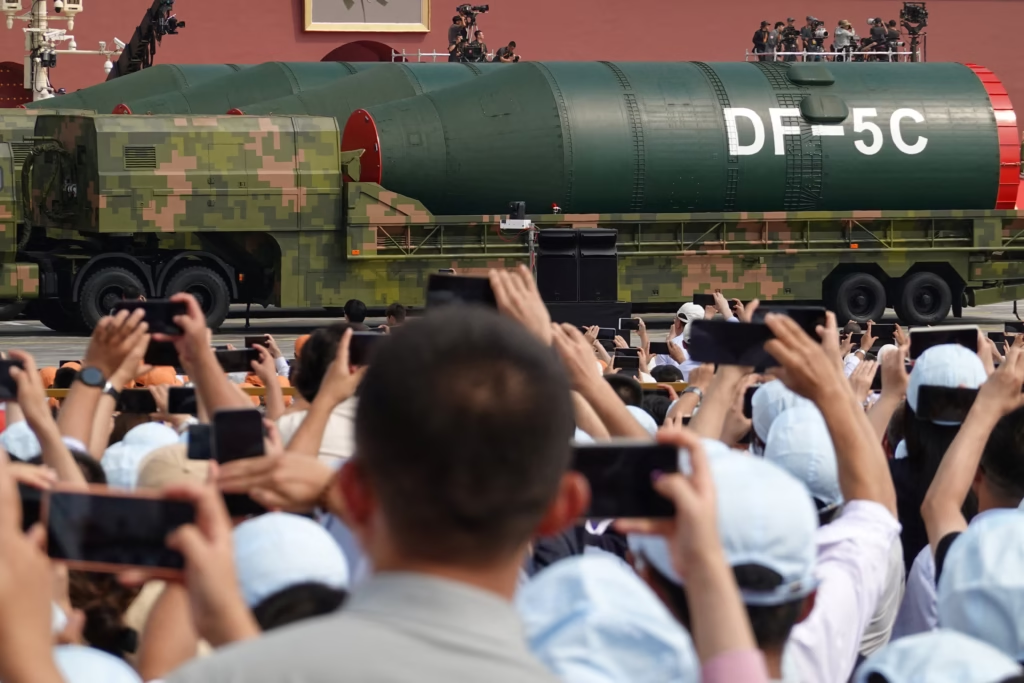On Sept. 3, 2025, Chinese President Xi Jinping presided over a huge military parade in Beijing that publicly displayed advanced weapons—including the DF-5C intercontinental ballistic missile, the new J-35A fighter, and a suite of hypersonic and anti-ship missiles—while foreign guests such as Russia’s Vladimir Putin and Pakistan’s Shehbaz Sharif looked on.

Impact
The parade marked the first time China showed what state media called a full nuclear triad (land-, sea-, and air-launched nuclear systems) in public and put a range of cutting-edge capabilities on display to a packed gallery of foreign leaders. Analysts say the timing and guest list amplified the geopolitical signal: Beijing is demonstrating deterrent reach, hypersonic advances, and anti-access tools at a moment of heightened regional tensions.
What was on display?
State and international reporting listed a broad array of systems rolled past Tiananmen and flown overhead. Key items included:
- DF-5C (Dongfeng-5C)—a liquid-fueled ICBM shown in the strategic strike group; Chinese outlets described it as a modernized DF-5 able to carry multiple warheads.
- Nuclear triad elements—Beijing presented Julang-3 (a submarine-launched intercontinental missile), Jinglei-1 (an air-launched long-range missile), and land-based DF series missiles (DF-61, DF-31).
- Hypersonic and anti-ship missiles—the Yingji (YJ) series (Yingji-17/19/20) and the DF-17 hypersonic glide vehicle family were among the hypersonic-class weapons paraded.
- Fighter jets and carrier aviation—flypasts featured stealth and carrier-capable types, including the J-20, J-20A/S, J-16D, and the newer Shenyang J-35A (air force variant), alongside the KJ-600 airborne early-warning aircraft.
- Directed-energy & electronic systems—Beijing also showcased anti-drone “triad” systems (missile-guns, high-energy lasers, and high-power microwaves), underwater drones, and new sea-launched unmanned systems.

Capability, theater, and optics
Chinese state media framed the parade as a concentrated display of domestically produced, active-duty equipment organized “in a manner reflecting their functions in real combat.” The international press noted the optics: the DF-5C was presented as an ICBM with global reach and MIRV capability (multiple warheads), while the public reveal of Julang-class SLBMs and an air-launched strategic missile was striking for signaling a visible triad. Still, several analysts warned that public display does not automatically mean all systems are fully operational at scale; some may be in early deployment or limited service.
Why now?
The parade commemorated the 80th anniversary of the end of World War II and came amid China’s broader campaign to show technological and military maturity. Hosting high-profile leaders—Russia’s Vladimir Putin and Pakistan’s Shehbaz Sharif among them—allowed Beijing to frame the event as diplomatic as well as military theater, signaling partnership with countries outside the Western security architecture. Observers link the display to long-term PLA modernization goals: building a tri-service deterrent, improving anti-access/area denial (A2/AD) in nearby seas, and advancing hypersonic and counter-drone capabilities.
Reactions and analysis
Western and regional analysts described the parade as both a technical showcase and a political message. Singapore-based analysts noted the parade forces defense planners to account for a broader set of threats—from hypersonics to undersea drones and directed-energy systems—even as they question operational readiness and numbers. Some commentators pointed out a marketing angle: the parade also places Chinese suppliers on a global stage for potential export customers.

Implications and watch points
- Operational verification: Militaries and intelligence services will monitor whether displayed systems enter sustained service, their deployment patterns, and test activity.
- Regional balance: Neighbors and partners (including India, Japan, and U.S. allies) will reassess force postures and missile-defense planning in light of hypersonic, anti-ship, and undersea drone capabilities.
- Arms control and diplomacy: The public triad and hypersonic displays will likely be raised in diplomatic channels and non-proliferation forums; expect renewed calls for transparency and arms-control dialogue.
Attribution & sources
Reporting for this article is based on coverage by Reuters, Al Jazeera, The Independent, Hindustan Times, and official Chinese state releases summarized in international reporting. Key factual claims about the weapons paraded (DF-5C, Julang-3, Jinglei-1, DF-61/DF-31, DF-17, Yingji series, J-35A, KJ-600, and directed-energy systems) are documented by Reuters and other outlets.
Conclusion
China’s parade was both a technical showcase and a geopolitical performance: the public display of a purported nuclear triad, hypersonic missiles, and advanced naval and air platforms—watched by global and regional leaders including Putin and Pakistan’s Shehbaz Sharif—sharpens strategic anxieties and will reshape defense planning conversations in capitals from Washington to New Delhi. The next weeks and months will be crucial for analysts to move from spectacle to verification: separating headline optics from operational reality.











